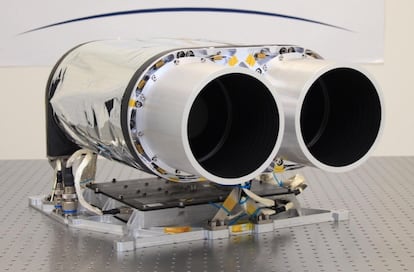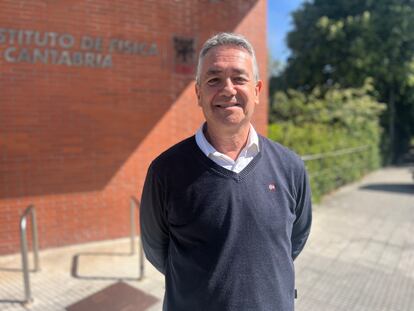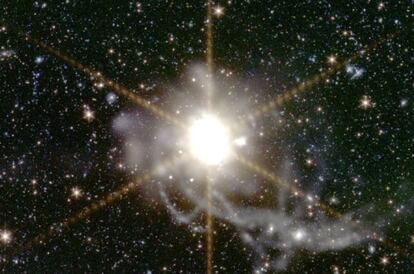A camera in space to photograph the unphotographable
For the first time, Spain is leading an ESA scientific mission, the ARRAKIHS project, to learn more about dark matter in the universe

The team’s task has not been easy. In recent months, the company Satlantis has been developing a camera to photograph the dark matter in the universe. In reality, the set-up consists of four complementary high-precision devices, two of them with infrared light, on board a 300-kilogram satellite. These cameras will observe the structures around small galaxies to study the distribution of this matter, which, to make matters more complicated, is invisible.
The project is called ARRAKIHS (Analysis of Resolved Remnants of Accreted galaxies as a Key Instrument for Halo Surveys). It is the first scientific mission of the European Space Agency (ESA) to be coordinated and led by Spain. It also features another peculiarity: “We are used to scientists defining the challenge and then consulting with industry. But, in this case, we go hand-in-hand from the outset,” explains Juan Tomás Hernani, founder and CEO of Satlantis, the company responsible for the core components of the satellite system — the so-called payload — and the development of the cameras.
Satlantis, based in Leioa, Bizkaia, is not starting from scratch. The firm has a decade of experience in Earth observation through these devices, for example in the detection of methane leaks or in the evaluation of the spectral traces of fires. Now, its cameras will rotate 180 degrees and focus on “nearby” galaxies, located between 82 and 130 million light-years away.
“We must place the satellite far enough away from Earth so that the albedo light does not disturb us. The chosen point is 800 kilometers (almost 500 miles) away from the surface, at a high orbit to be able to correct the spin and always look at the same star, always with our back to the Sun,” explains Hernani, who has previously served as Spanish Secretary of State for Innovation (2009-2012).

Camera resolution
The optics of the cameras are defined as “super-precise” due to their lenses, with a tolerance of one micron and 40 nanometers of roughness. “If these same cameras were placed 500 kilometers from our planet to observe it, they would provide us with a resolution of 80 centimeters of pixel. We would be able to recognize, for example, a car or fruit trees,” says Hernani.
The head of the ARRAKIHS project at ESA, Carlos Corral van Damme, adds that “the key to this precision will be in the planning.” From the agency’s main center for the development of satellites, located in the Netherlands, where he talks to EL PAÍS, Van Damme explains that “the mission will have to accumulate 150 hours of observation in at least 75 nearby galaxies to know the structures in the halo with very low surface brightness.” The process would be more or less similar to that which occurs in a photograph with a very long exposure, in order to be able to “obtain a small number of photons.” Only in this case, we are talking about 900 exposures per galaxy of 10 minutes each.
The lack of knowledge about dark matter astonishes and excites the scientific community in equal measure says Van Damme, a Spaniard of Belgian descent. So does another of his mission partners, Rafael Guzmán, who has returned to Spain as leader of the consortium responsible for ARRAKIHS after three decades of professional work in California and Florida. “Dark matter reflects the ignorance of what we still don’t know about the universe,” notes Guzmán.
So far, science is aware of its existence “because it responds to the laws of gravitation,” says Guzmán. The astrophysicist, who is also a research professor at the Institute of Physics of Cantabria (IFCA), adds: “We cannot see it, but we can study the effect it has on elements composed of atoms or molecules.” In other words, these scientists will infer the properties of dark matter from its interaction with objects comprised of normal matter.
If all goes according to plan, they could obtain results contradictory to the empirical evidence. Currently, standard cold dark matter models predict that galactic halos should have a much clumpier structure than observed. “If they are correct, 95% of the universe is in an unknown form, and only 5% corresponds to all detected planets, stars or galaxies,” Guzmán stresses. In the same way, dark matter would also make it possible to determine, firstly, the age of the universe and, secondly, its future, i.e., “whether it will always expand, or whether there will come a time when it collapses in on itself.”

The ARRAKIHS mission consortium currently consists of five countries. Switzerland and Sweden focus primarily on the theoretical aspect, including the models whose predictions will be tested in this mission. The work of Austria and Belgium is linked to different instrumentation systems. The leadership of all this work lies with Spain. This international group is made up of 120 professionals divided into three areas: on the one hand, the astrophysicists, physicists and mathematicians; on the other, the engineering community from a wide variety of fields; and finally, the scientists and managers who coordinate the work.
ARRAKIHS is part of one of ESA’s Fast class missions. These missions are characterized by their “low” budget and the fact that no more than 10 years elapse between selection and launch, as the project leader specifies. In fact, an important milestone was reached last March: ESA approved the completion of Phase A, consisting of a review of the photographic instruments.
The team is now working to complete Phase B by the first half of 2026. To do so, they will have to prototype the equipment and validate whether it would work in the extreme conditions of the thermosphere, where temperatures can reach as low as minus 120ºC. The starting point is that Satlantis cameras have already been validated in space. The satellite is scheduled for launch in 2030.
Van Damme is also looking forward to this horizon, without losing sight of the project’s accounts. “The ESA budget allocated to ARRAKIHS is €200 million ($217 million) for the construction of the satellite and preparation of the ground segment, launch, and mission operations,” he explains. However, to this amount would have to be added the funding for the development of the instrument “which is borne by Spain and other countries,” and several “additional costs” to be assumed by the rest of the consortium. As such, Van Damme does not dare to venture a final figure, much less at this stage of the mission.
What he is clear about is that “there has been a clear will for growth and involvement of Spain in the space sector.” In recent years, he perceives a “more active and leading role in many missions, from contributions to leadership,” as in the case of ARRAKIHS.
Sign up for our weekly newsletter to get more English-language news coverage from EL PAÍS USA Edition
Tu suscripción se está usando en otro dispositivo
¿Quieres añadir otro usuario a tu suscripción?
Si continúas leyendo en este dispositivo, no se podrá leer en el otro.
FlechaTu suscripción se está usando en otro dispositivo y solo puedes acceder a EL PAÍS desde un dispositivo a la vez.
Si quieres compartir tu cuenta, cambia tu suscripción a la modalidad Premium, así podrás añadir otro usuario. Cada uno accederá con su propia cuenta de email, lo que os permitirá personalizar vuestra experiencia en EL PAÍS.
¿Tienes una suscripción de empresa? Accede aquí para contratar más cuentas.
En el caso de no saber quién está usando tu cuenta, te recomendamos cambiar tu contraseña aquí.
Si decides continuar compartiendo tu cuenta, este mensaje se mostrará en tu dispositivo y en el de la otra persona que está usando tu cuenta de forma indefinida, afectando a tu experiencia de lectura. Puedes consultar aquí los términos y condiciones de la suscripción digital.
More information
Archived In
Últimas noticias
Most viewed
- Why we lost the habit of sleeping in two segments and how that changed our sense of time
- Charles Dubouloz, mountaineering star, retires at 36 with a farewell tour inspired by Walter Bonatti
- Venezuela faces its most tense Christmas yet
- CBS in crisis after pulling a report on Trump’s deportations to El Salvador (which later leaked online)
- Bukele clan fumes over investigation exposing their new wealth










































